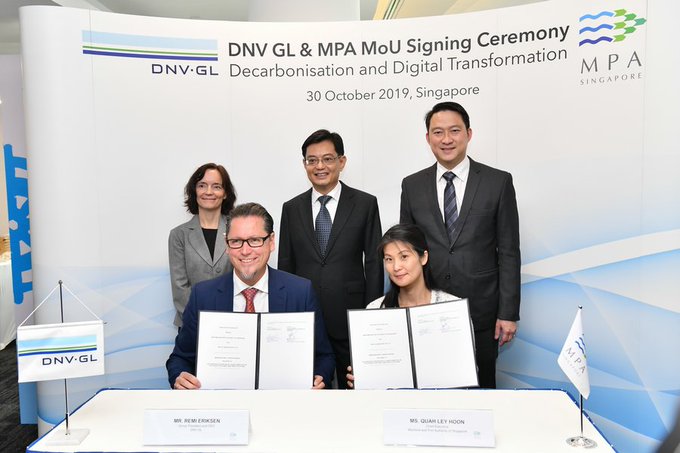Under the sidelines of this year’s Global Marine Forum, which took place in Singapore 30-31 October, Heng Swee Keat, Singapore’s Deputy Prime Minister and Minister for Finance, announced the launch of ‘digitalPORT@SG’, country’s maritime single window system that aims to drive decarbonisation and digital transformation.
During his opening speech, DPM Heng stressed that currently, international trading system, climate change and technological advancement are the three key trends that incentivise change in the industry. As such, to stay relevant and keep pace of the developments, the industry needs to ‘ride the winds of change and the waves of disruption’, he highlighted.
In recent years, the global trading system has come under stress; trade frictions are rising, investors are facing greater uncertainty and the benefits of growth have been unevenly distributed,
…DPM Heng commented.
Providing a brief description of the reasons why global order is under pressure, he called for cooperation to review and update the global rules. “The benefits of a global division of labour are considerable, and it is critical that countries work together and uphold our multilateral system and institutions,” he stated.
Stressing that climate change is amongst the top challenges for many parts of the world and particularly for States like Singapore, he confirmed that the country is committed to doing its part under the Paris Agreement and reduce Singapore’s emissions intensity by 36% from 2005 levels by 2030.
‘We believe that Singapore can do more’ he continued his speech and explained which actions are underway. Namely, in line with supporting country’s LNG bunkering ecosystem, MPA Singapore has co-funded two LNG bunker tankers, the first to be delivered until Q3 of 2020 while it has also set up the Centre of Excellence for Maritime Energy and Sustainable Development at the Nanyang Technological University to bring innovation within maritime operations, emissions management and energy management.
He then announced the official launch of Singapore’s new maritime single window for vessels, the ‘digitalPORT@SG’ where PORT stands for Portal for One-stop Regulatory Transactions. He also explained that this will be developed in two phases:
In phase 1, users can obtain approval for all arriving and departing ships for MPA, the Immigration & Checkpoints Authority and the National Environmental Fence through a single portal. Namely, the portal will consolidate up to 16 separate forms into a single application, which is expected to save the industry approximately 100,000 man-man-hours annually.
Also, in this phase, which is expected to progressively rolled out from December 2019, data exchange with port community systems such as Portnet and Jurong Port Online will be possible in order to receive information including declaration on dangerous goods operations and port terminals.
In phase 2, expected for operation after two years, the system will serve as a single digital shopfront for booking terminal and marine services, facilitating just-in-time (JIT) operations for optimal vessel passage planning within the port of Singapore.
We also hope to make digitalPORT@SG interoperable beyond Singapore’s shores so that industry players can gain greater operational efficiency,
…DPM Heng said.
So far, MPA has signed an MOU with the China Maritime Safety Administration to cooperate on the use of electronic certificates for ships which allows for seamless exchange of ship credential for port regulatory functions. For this reason, Singapore collaborates with Denmark, Finland and Panama.
DPM Heng highlighted that the scope of this new maritime single window is to assist in data sharing, connecting at the same time seas and oceans with a “single digital ocean”.
Concluding this speech, DPM Heng highlighted that a more sustainable future requires collective action of all industry stakeholders.
Together, we must be prepared to agree and make bold moves to position the maritime sector well for the future. If we stay focused on the future and work together, we can chart a forward-looking course for the global maritime community for many more years to come,
…he added.
Meanwhile, DPM Heng joined Dr Lam Pin Min, Senior Minister of State for Transport and Health, to witness the signing of a MoU between Ms Quah Ley Hoon, Chief Executive of MPA and Mr Remi Eriksen, Group President and CEO of DNV GL.
The MoU maps out a three-year R&D collaboration in the key areas of decarbonisation and digital transformation for sustainable and smart maritime ecosystems including:
- New maritime business and operation models utilising additive manufacturing for ship spares and blockchain technologies for port and shipping processes;
- Market and technical feasibility research of low and zero carbon ship fuels such as Bio-LNG, as well as battery and battery-hybrid for short-sea applications;
- Autonomous and remote controlled ships as well as shore-based operation and control centres; and
- Curate maritime-related thought leadership forums to foster closer collaboration and exchange of views between public and private sector.

Specifically, under the MPA-DNV GL MoU, the partners will cooperate on R&D projects including printing and technical validation of additive manufacturing for ship spares, concept of operations, business needs and hazard identification for remote operations of engine control centres for deep ocean-going ships, smart ship Internet-of-Things (IoT) best practices to accelerate the
development of IoT sensor and data collection in the industry, proof of concept use of blockchain technology for Singapore ship registration process, as well as technical feasibility studies of low cost LNG retrofit solutions for ship use and risk, safety, availability, market developments and sustainability impact study of bio-LNG as an attractive low carbon alternative marine fuel.



































































